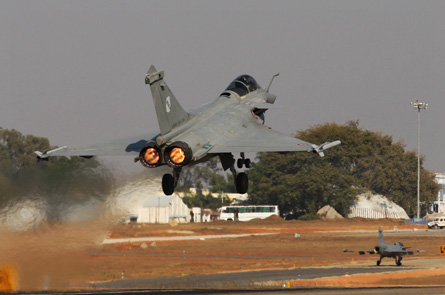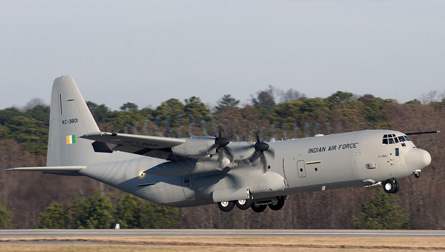India's medium multi-role combat aircraft (MMRCA) competition has all the hallmarks of a classic Indian love story, Bollywood-style. In the late 1990s the Indian air force loved its French Dassault Mirage 2000 aircraft, and in 2001 said it favoured buying 126 more. But India dithered, Dassault decided to pitch the Rafale instead, and in 2004 New Delhi decided to tender, with five other suitors emerging to woo its air force. Only after a decade of high drama did the service return to the eager arms of its first true love, the French.
More drama may lie ahead. Dassault has confirmed it and partners Snecma and Thales have attained L1 vendor status in the competition, meaning they will eventually enter exclusive negotiations linked to the 126-fighter deal. But while the French are in prime position, there is a long road ahead. Media reports suggest the companies and nations behind the Eurofighter Typhoon are willing to cut their price in a last-ditch attempt to thwart a Rafale deal, and there are persistent rumours the USA hopes India will drop the MMRCA process altogether and buy the Lockheed Martin F-35 Lightning II instead.
 |
|---|
| © Indian Defence Ministry Dassault should not take victory for granted, yet |
In addition, recent precedents suggest a Dassault win is far from certain. In 2007, Eurocopter was poised to clinch a 197-aircraft tender for light utility helicopters, but the competition was abruptly cancelled owing to allegations of irregularities in the selection process. In another example, New Delhi selected the Airbus Military A330 multi-role tanker transport, but its purchase was cancelled after its finance ministry raised concerns over the price tag.
However entertaining outside observers have found the $10-20 billion MMRCA competition, it is impossible to understate the winner's crucial role in the modernisation of the Indian air force. Despite its significance, however, MMRCA is only one element in a broad effort that also includes major indigenous combat aircraft, a competition for new tankers, and enhanced airlift capabilities. The Indian navy is also modernising, with new aircraft carriers in the pipeline and ambitious plans to improve oversight of India's vast oceanic frontiers.
"Adding a capable, reliable, high-end jet to India's fighter force will be transformational," says Teal Group analyst Richard Aboulafia. "Most of the Indian air force is comprised of either lighter, older planes such as the [Mikoyan] MiG-21 or Sepecat Jaguar, or heavier, but not completely reliable, Sukhoi Su-30s.
"The best part of their fleet is the 50 or so Mirage 2000s, which are almost medium fighters and relatively modern. India has never had a significant force of capable, reliable planes. Whether they get Rafales or Eurofighters, they'll get a significant number of modern, medium/large capable jets. That represents a major qualitative improvement."
Certainty of this qualitative improvement has moved closer with Dassault's coveted L1 status, but it is not yet within the grasp of either the French or their customer. By late February, the Indian defence ministry had still not made a formal announcement on Dassault's L1 status, and was uncertain about the timeframe for this. "Nothing is official yet," according to a defence ministry source.
Assuming the formal granting of L1 status for Rafale, final negotiations between Dassault and the Indian government's Contract Negotiation Committee (CNC) could take between six months and one year. According to defence ministry tender guidelines, a CNC should comprise individuals representing the stakeholders involved in an acquisition. In the case of MMRCA, an industry source believes the air force, Hindustan Aeronautics (HAL) and other key parties will be represented.
The CNC will conduct a two-stage negotiation. The first will deal with details such as contract language and deliverables, the second with pricing. On clearing the CNC, the contract will need the approval of the Defence Acquisition Council and India's finance ministry. Finally, the package will go before India's Cabinet Committee on Security, which will give the final sign-off.
"The L1 price is not necessarily the price you will win with," says the source. "There will be multiple stakeholders involved in the decision and negotiations."
Aboulafia also questions the true cost of the MMRCA deal, as the winner is required to plough 50% of the contract value into offsets.
"India needs to understand the cost of offsets," he says. "While technology transfer and local manufacturing sound good, they are an extremely expensive mark-up to an already pricey aircraft deal. The selection of the 'lowest cost' aircraft is somewhat surreal. Nothing about this project is low cost at all, so it's like choosing between a Ferrari and a Lamborghini on the basis of the sticker price."
Under the terms of the award, 18 aircraft will be delivered in a flyaway condition, with 108 to be built under licence by HAL. Although the Rafale has struggled in late-stage negotiations in Brazil and the United Arab Emirates, recent French wins on the subcontinent bode well for the successful conclusion of Dassault's MMRCA campaign.
In July 2011, the company won a long-awaited $2.2 billion deal to upgrade the Indian air force's Mirage 2000H fighters to its Mirage 2000-9 standard. In early January, missile-maker MBDA confirmed a deal to equip the modified aircraft with Mica air-to-air missiles, although an official contract has yet to be signed.
One of India's major goals in the MMRCA competition is to boost its indigenous aerospace sector, but media reports from the subcontinent frequently suggest the country continues to struggle with high-profile programmes such as the Aeronautical Development Agency (ADA) Tejas light combat aircraft and the Dhruv advanced light helicopter.
Despite conveniently achieving initial operational capability only weeks before last year's Aero India show in Bengaluru, the Tejas is reportedly nowhere near achieving final operational capability, although it conducted about 240 test flights in 2011.
A naval variant of the Tejas, unveiled in 2010, has yet to conduct its first flight, despite a programme official's confidence last year that the aircraft would fly in October or November 2011. Indeed, The Hindu newspaper recently quoted Chief of the Naval Staff Admiral Nirmal Verma as saying the ADA had "let the service down" with the naval version of the Tejas. After completing initial test flights, the aircraft will still need to prove itself capable of ramp-assisted take-offs and arrested landings for carrier-based operations.
 |
|---|
| © Lockheed Martin The Indian air force has received all six Lockheed Martin C-130J Hercules ordered in 2008, and is in talks to obtain six more |
Meanwhile, New Delhi is co-operating with Sukhoi to develop the fifth-generation fighter aircraft, a variant of the company's PAK-FA/T-50 design. It has also conducted a study into the indigenous fighter known as the medium combat aircraft (MCA), which would be a stealth type similar to the F-35.
Both plans are highly ambitious and could yield fruit, but the record of HAL and the ADA with the relatively basic Tejas suggests an extremely challenging development period for both fighters, especially the MCA.
Aside from a cloudy outlook on the fighter front, India's acquisition of a new basic trainer has also been delayed. India's Cabinet Committee on Security was due to approve a deal to buy 75 Pilatus PC-7 Mk IIs as flyaways, with another 106 produced under licence by HAL. A protest by the South Korean government has apparently delayed this deal, with the Korea Aerospace Industries KT-1 having also been involved in the competition. However, an industry source says questions from the Ministry of Finance about the tender are behind the delay.
Any hold-up in the procurement is troublesome for the air force, which suffers a profound capability gap in basic training and arguably needs a new capability more urgently than any other type. The service's HAL HPT-32 Deepak basic trainers were grounded in July 2009 following a series of crashes.
However, India appears to be making progress with its renewed competition for additional tankers, with Airbus Military confirming in January that the nation had completed trials of the A330 MRTT and rival Ilyushin IL-78MK. The air force plans to acquire six tankers initially, followed by more to augment its existing active inventory of seven Il-78s.
An off-the-shelf purchase of attack helicopters is also progressing, with Boeing confirming at the Singapore Airshow in February that its AH-64D Apache Longbow is poised to win a 22-aircraft contract after seeing off Russia's Mil Mi-28. India's air force also plans to obtain 65 HAL light combat helicopters with deliveries to start in 2013-2014.
Transport is proving to be a bright spot for the Indian air force. It has received all six Lockheed Martin C-130J Hercules ordered in 2008, and is in talks to obtain six more. India will also begin receiving 10 Boeing C-17s in 2013-2014, and 105 Antonov An-32s are being steadily upgraded with significantly improved avionics.
Work is also well under way on India's Boeing 737-based P-8I maritime patrol aircraft. In February, Raytheon announced it has delivered the first APY-10 surveillance radar for the aircraft, eight of which will enter navy service. The radar is specifically customised for India, with its surface search capability built on with air-to-air and weather modes. India is obtaining eight P-8Is.
While India appears to be doing well with the acquisition of key support aircraft, its main challenge remains to fill out its fighter squadrons and obtain a modern basic trainer. The situation will only grow more challenging as Pakistan increases its force of Chengdu/Pakistan Aeronautical Complex JF-17 Thunders, and China develops its high-altitude airfields in the Himalayas. The Indian air force's future MMRCA fleet is essential to counter these threats.
Four-hour Bollywood movies are great fun while they last, but all the singing and dancing account for nothing without a decisive finale.
Source: Flight International























